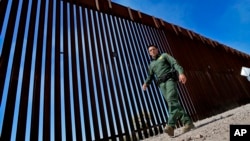Fears that Hamas’ deadly terror attack on Israel could help spark a wider conflict or even terror attacks in the United States have yet to materialize into actual threats, according to U.S. officials, but that has not stopped concerns from spreading.
The focus on the potential threat has grown in recent days following the appearance online of an apparent Customs and Border Protection, or CBP, memo warning that operatives with links to Hamas, Palestinian Islamic Jihad or Hezbollah might try to enter the U.S. along its southern border.
The U.S. has designated all three groups as Foreign Terrorist Organizations.
“Individuals inspired by or reacting to the current Israel-Hamas conflict may attempt travel to or from the area of hostilities in the Middle East via circuitous transit across the Southwest border,” according to the memo, first obtained by The Daily Caller.
The document, from the CBP’s San Diego field office, further warns, “Foreign fighters motivated by ideology or mercenary soldiers of fortune may attempt to obfuscate travel to or from the U.S. to or from countries in the Middle East through Mexico.”
It then shows insignias associated with each of the groups and suggests questions that could help identify a foreign fighter.
CBP declined to confirm the authenticity of the memo but, in a statement to VOA, downplayed the threat.
“CBP has seen no indication of Hamas-directed foreign fighters seeking to make entry into the United States,” a spokesperson said.
The spokesperson also said CBP “provides frontline personnel a wide range of context for situational awareness in order to ensure they remain vigilant in fulfillment of our homeland and border security missions.”
“Situational awareness briefs are not threat assessments,” the spokesperson said.
Concerns that the Hamas terror attack and Israel’s subsequent military response could spill over into U.S. streets spiked earlier this month when a former Hamas leader called for a day of rage, urging Muslims "to join in the fight" and deliver a "message of anger" in support of the militant group’s fight against Israel.
Police departments in New York, Los Angeles and Washington heightened security as a precaution. And the U.S. Department of Homeland Security hosted a call for almost 4,000 law enforcement agencies across the country to review the security environment and share additional resources.
Despite the concerns, a homeland security official said at the time that the department had “no specific credible intelligence indicating any potential threat to the homeland at this time."
"If any information is developed that would require that we adjust our security posture to protect the homeland, we are, of course, prepared to do that," the official said.
DHS threat assessments have also warned, repeatedly, that the biggest danger is homegrown, not foreign, and "marked by lone offenders or small group attacks that occur with little warning."
Officials expressed concern that the volume of videos and propaganda flooding social media could serve as an accelerant.
Some U.S. lawmakers have been raising concerns about the potential for terrorists to use the border with Mexico as a gateway into the U.S.
“The number of individuals with derogatory information in terrorist screening databases illegally crossing the southwest border has also skyrocketed during the Biden Administration,” the Republican chairmen of the House Oversight, Judiciary and Homeland Security committees wrote in a letter to Homeland Security Secretary Alejandro Mayorkas last month. The letter warned of an “elevated national security risk.”
CBP officials maintain that “encounters of known and suspected terrorists at our borders are very uncommon.”
But a spike in migration across the Americas has raised the stakes.
“We obviously are concerned that with that increase, you might have an increase in people who might come over with malign intentions, including potential terrorists,” the DHS undersecretary for intelligence and analysis told an audience in Washington last month.
Kenneth Wainstein said the department was working closely with the FBI to better identify anyone potentially affiliated with terror groups. The department’s various entities have "significantly ramped up their operations to ensure that we're identifying any such bad actors before they come across," he said.
More recently, DHS officials said there have not been any signs that terror groups are seeking to exploit migration patterns.
“We just haven't seen information at all that would suggest that at this stage,” an official said earlier this month, briefing reporters on the condition of anonymity because they were not authorized to speak publicly.
Still, other eyes are also keeping watch, especially when it comes to Hezbollah, an Iranian-linked group known to operate in Central and South America.
The U.S. is "watching very, very closely," the commander of U.S. Southern Command said during a forum in Washington earlier this month.
"Working with our partner nations, obviously they're concerned, too," Gen. Laura Richardson said in response to a question from VOA.










